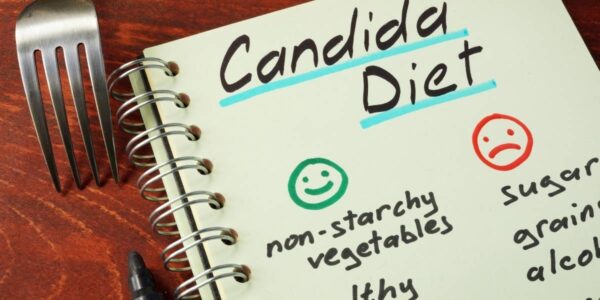Health issues can arise from an overgrowth of Candida, a yeast that naturally occurs in the body. Many individuals find relief from their symptoms by adopting a Candida Dieetti. In this article, we will delve into the Candida Diet, providing you with a clear understanding of its core principles and how they can help restore balance to your body. It’s time to embark on the path to improved health and well-being.
Understanding Candida Overgrowth
An overgrowth of the yeast Candida, typically found in the human body, can disrupt the delicate balance of the microbiome. Possible causes include a compromised immune system, unhealthy dietary habits, prolonged antibiotic use, or extreme stress. Candida overgrowth can lead to a wide range of symptoms, including digestive issues, fatigue, recurrent yeast infections, and skin disorders.
What Is a Candida Diet?
One therapeutic approach to addressing Candida overgrowth is to restrict the intake of substances that feed the yeast. The Candida Diet aims to restore gut flora, starve Candida yeast, and enhance overall health by combining specific food categories and supplements.
Foods to Avoid
- Sugar and Sweeteners: Candida thrives on sugar, so it’s crucial to avoid all sources of added sugar, including desserts, sweetened beverages, and artificial sweeteners.
- Refined Carbohydrates: Refined carbs like white bread and pastries can be quickly converted into sugars, fueling Candida growth. Opt for high-fiber alternatives like whole grains.
- Processed Foods: Processed foods containing chemicals, preservatives, and hidden carbohydrates can exacerbate Candida overgrowth. Prioritize fresh, wholesome meals to reduce exposure.
- Alcohol and Caffeine: Both alcohol and coffee can weaken the immune system and disrupt the gut microbiome’s balance. Limit or avoid beverages high in caffeine and alcohol while on a Candida Diet.
Foods to Include
- Non-Starchy Vegetables: Non-starchy veggies are lower in carbohydrates and rich in fiber, vitamins, and minerals. Incorporate a variety of vegetables, from leafy greens to cruciferous ones like broccoli and cauliflower.
- Probiotic Foods: Probiotic-rich foods promote the growth of beneficial gut bacteria. Include fermented foods like yogurt, kefir, sauerkraut, and kimchi in your diet.
- Healthy Fats: Foods high in healthy fats, such as avocados, almonds, seeds, and olive oil, provide nutrition and support the body’s anti-inflammatory response.
- Lean Proteins: Sources of lean protein like chicken, fish, tofu, and lentils aid in tissue regeneration and overall well-being. Whenever possible, opt for organic, high-quality protein sources.
Supplements and Natural Remedies
Combining dietary changes, vitamins, and natural therapies can help combat Candida overgrowth. Consult your healthcare provider before incorporating them into your daily routine. Commonly recommended options include:
- Probiotics: Replenishing beneficial gut bacteria with probiotic supplements can strengthen the immune system and mitigate the effects of Candida overgrowth. Consider strains like Lactobacillus acidophilus and Bifidobacterium bifidum, both effective against Candida.
- Antifungal Herbs: Herbs with antifungal properties, such as garlic, oregano, and pau d’arco, can help manage Candida overgrowth. You can consume them with meals or as supplements.
- Digestive Enzymes: Digestive enzymes, including amylase, protease, and lipase, assist in food digestion and nutrient absorption. Supplementing with these enzymes may be beneficial during a Candida Diet.
Lifestyle and Additional Tips
In addition to dietary changes, modifying your lifestyle can enhance the effectiveness of a Candida Diet. Consider:
- Reducing stress through mindfulness practices, regular exercise, and adequate sleep.
- Maintaining oral hygiene and avoiding sugary beverages to minimize oral Candida.
Common Misconceptions About the Candida Diet
While the Candida Diet has garnered attention, it’s important to dispel certain misconceptions:
- Not a Universal Solution: The Candida Diet may not address all health issues.
- Temporary Measure: It’s a therapeutic measure, not a lifelong diet.
- Individual Responses Vary: People may react differently to the diet, so professional guidance is advisable.
Conclusion
The Candida Diet is a systematic approach to combat yeast overgrowth and restore health. By avoiding foods that promote Candida growth and replacing them with nutritious options, along with taking essential supplements and making lifestyle changes, individuals can support their journey toward improved health and well-being. Remember, tailoring the diet to your specific needs and achieving the best results should involve consultation with a healthcare practitioner.
FAQs (Frequently Asked Questions)
-
How long does it take to see results on a Candida Diet?
- The time it takes for noticeable changes to occur with dietary and lifestyle adjustments can vary widely, ranging from weeks to months.
-
Can eliminated foods be reintroduced into the diet?
- Some individuals successfully treated for Candida overgrowth can slowly reintroduce previously avoided foods. However, monitoring your body’s reactions is essential to make necessary adjustments.
-
Is the Candida Diet meant to be followed indefinitely?
- Contrary to common belief, the Candida Diet is not intended for lifelong adherence. Once balance is restored, a healthy diet emphasizing whole foods and mindful eating can be implemented.
-
Can the Candida Diet help with other health conditions?
- While primarily designed to address yeast overgrowth, the Candida Diet may also improve digestion and immunity. However, it should not replace medical advice.
-
Are there potential side effects of the Candida Diet?
- Some individuals may experience transient symptoms like headaches, fatigue, or digestive disturbances as their bodies adapt to the new diet. These symptoms typically subside within a few days.

